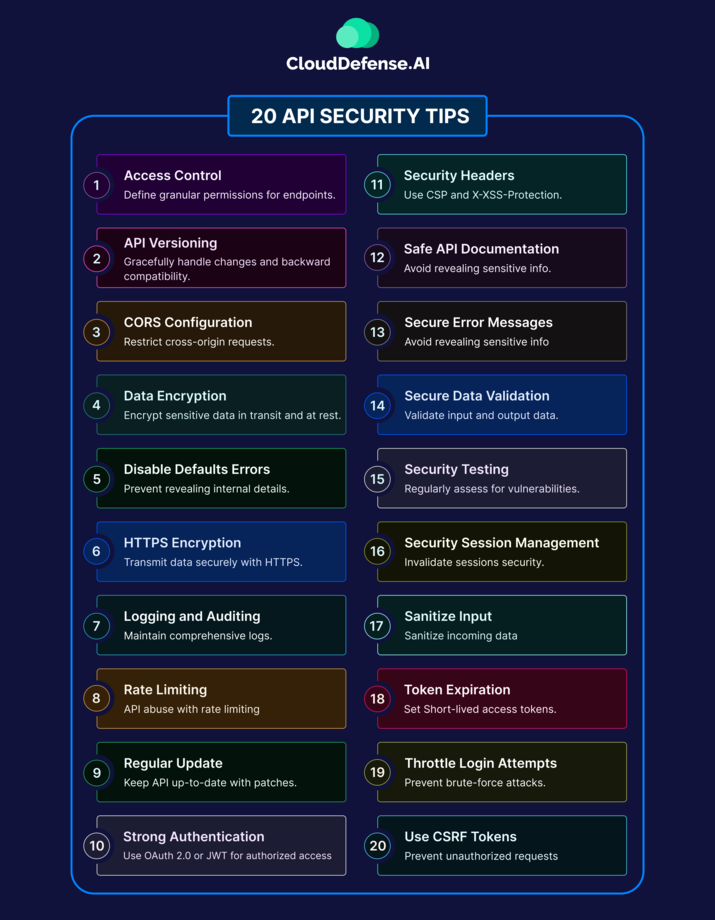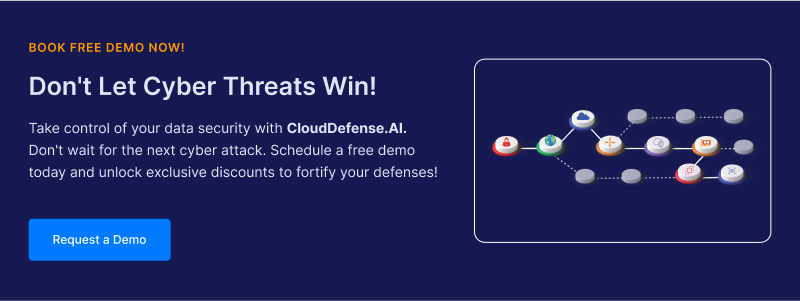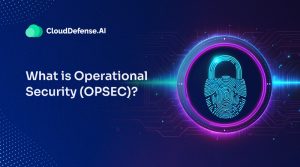API has become an essential aspect of modern cloud computing, and most organizations nowadays utilize API to access different tools. It allows users to utilize one piece of tool or application while using another one, and that too, without having to install the tool in the system.
Nowadays, most modern applications have an API that is available to external users, and they can request the service whenever needed. Various important and sensitive data are transferred when an API and system interact. An insecure API becomes a simple target for malicious users to get into any secured network and steal all the sensitive data.
That is why it has become imperative for organizations to utilize best-in-class API security that protects the APIs from falling victim to malicious attacks. In this guide, we will take you through all the aspects of API security and give an overview of how services like CloudDefense.AI can protect the APIs of your applications.
What is API Security?
API or application program interface security defines the process and policies of effectively securing APIs from any kind of attacks and mitigating the attempts to get into the APIs. Since API serves as the gateway of most web-based applications, it has become a prime target for most hackers who want to get into the system to steal data or disrupt the service.
APIs allow outside users to access all the features of an application, and this creates a huge risk as an attacker can quickly get entry with ill intent. Some common attacks performed by attackers are MITM, DDoS, Injection, DoS, or Broken Access Control Attacks. So API security secures all these vulnerabilities and misconfigurations by employing strategies and techniques to ensure only authorized users can gain access to the API.
Previously, basic authentication was required to gain access to APIs but to mitigate risk, different security tokens like API gateways and MFA have been introduced. When sensitive data is transferred via API, the security guarantees complete security and makes sure that data is only available to users and applications with proper permission.
As most applications nowadays utilize API for accessing tools, API security has also become a core part of modern web application security. It lies at the intersection of application security, information security, and network security. API security is not only about securing data, but it also deals with many other security aspects like monitoring & analysis, content validation, identity-based security, rate limiting, and many others.
Before heading into more details, let’s first learn about;
What is API?
An API stands for application program interface, which contains code and protocols that enables two applications to communicate with each other and share data. API creates a bridge between two software components or services and allows them to share data and functionality.
Weather applications on smartphones are prime users of APIs as these apps get weather data from various services through APIs and provide you with weather updates. APIs are highly useful for developers because it helps them to use the functionality of other applications and make the development process much more convenient.
Most of the APIs that you utilize are primarily based on Representational State Transfer or Simple Object Access Protocol. Besides sharing data, API also helps in monitoring how an application is permitted for communication through API and also controls the types of requests exchanged. API is also responsible for communicating data with external users and customers.
There are different types of API that you will come across; some are public or private, and open or closed, while some are dependent on the architectural standard. Some common exam APIs that you use on a daily basis are payment processing, smart homes, medical monitoring, video conferencing, and many others.
Why is API Security Important?
In modern days API serves as a backend framework for modern applications as it allows communication between applications and allows users to use different non-native functionalities.
The rise of the Internet of Things, SaaS, web applications, and mobile apps has boosted the use of AP by a considerable margin. According to Postman, around 1.13 billion API calls were made in 2022, and there were 20 million users. However, this increased integration also made a significant rise in security issues and potential attack surfaces.
Salt Security’s report stated that around 94% of businesses around the world faced security issues in production APIs, and there was a 400% increase in unique attackers. Since API provides a pathway to sensitive data, resources, codes, and various PII, it has become a prime target for bad actors.
So adopting API security has become more critical than ever. Most web service providers have directed partners and users to ramp up the security protocols and incident response measures. The use of MFA has become a norm for API access because it involves multiple authentication methods to verify a user’s identity.
Top providers like Amazon, Microsoft, and Google have made many efforts by bringing advanced policies to enhance API security. Enforcing API security not only mitigates vulnerabilities and the chance of stealing data but also prevents many attacks that disrupt the whole network. Moreover, API security is also vital for ensuring the smooth performance of API and applications dependent on them.
Check our guide one top 10 OWASP Vulnerabilities
Anatomy of an API Attack: Everything You Need To Know
Applications, especially cloud-based apps, have become an integral part of modern businesses, and all these apps are dependent on API to ensure smooth functioning.
Thus, attackers always look for loopholes that will give them access to the application or ways to exploit the network. Here I will show the anatomy of how an attacker targets an e-commerce platform through its application and gets access to all the sensitive data;
- Step 1: At first, the attacker looks at the codes and reverse engineers the e-commerce app, and looks for loopholes in the API. The attacker discovered an API endpoint URL linked to a backend microservice that was used for getting data.
- Step 2: Next, the attacker correctly assesses the denounced API and finds out there isn’t any kind of authentication, including MFA, needed for making API calls to the backend microservice.
- Step 3: The attackers now conduct an array of automated analyses to find out whether the input field can be utilized for an SQLi attack. Since the API endpoint URL gives a unique product identifier through numeric value, the check on the input fields becomes a thriving source for the attacker to carry out the attack.
- Step 4: Then, the attackers exploit the SQLi vulnerability and deploy a shell command in the backend microservice that is linked to the central SQL database. By running the shell command, the attackers input a malicious application which is basically a Bitcoin mining executable, and execute it in the database.
There are various other ways API attacks happen, and it is done chiefly through exploiting the API vulnerabilities that are sometimes overlooked. Besides executing Bitcoin mining apps, the attacker may perform various attacks to disrupt the service, abuse the resources or tamper with the data.
Top API Security Risks
API security risks are a significant issue faced by security teams of many businesses, and there is no definite checklist to mitigate the risk. Every day new risks appear, and attackers try to exploit them to get entry. API gateway only offers visibility to the gateway traffic rather than the internal traffic, which leads to huge gaps. Here are some top API security threats that you should know;
- Poor coding: Poor coding is a major API security risk where poor skill in API development leads to security gaps in the API. Attackers can easily find loopholes to exploit the API and get access to the application.
- Authorization error: An improper management of authorization that is used for determining the access level of a user leads to API security risks. An authorization error causes an API user to get access to data that is not needed, and it increases the chances of attack.
- Insecure API key generation: It is also a major API security risk where the attacker uses a considerable number of API keys from users and hinders the protection. APIs are protected either through an API key or JSON Web Token, and these security tools block access to API keys when they detect any malicious activity. However, attackers were able to bypass this by using a bunch of API keys from users.
- DDoS attacks: DDoS attacks also pose a massive threat to API security as DDoS protection is designed only to identify and reject access requests. In various business models, customers are allowed to use the API platforms without requiring any API key, and this causes issues in DDoS protection. Moreover, every traffic will look like bot traffic for DDoS protection, so it won’t be able to reject requests.
- Incompetency in API: Usage of redundant API can lead to major API security issues as attackers might be able to get hold of them. Repetitive API usage occurs mainly when no API governance would monitor the usage of API and decide their longevity.
- Insufficient logging: The lack of API logging or API logs getting deleted sooner than expected plays an instrumental role in leading to API security risks. The lack of defined API security practices for API logging allows hackers to exploit this vulnerability, and it helps them to build further issues.
- Inability to handle authorization: Most API developers utilize API keys or OAuth for authentication purposes, but they were unable to define authorization separately. Most of the time, they miss out on authorization while testing web applications, and this creates loopholes for hackers. These hackers can try a series of IDs utilizing iterations and then finally enter the application.
- Accidental non-HTTP request: Accidentally sending a non-HTTP request from the web application exposes the API keys and it allows attackers to get access to the app. Much data is easily leaked through misconfigurations in SSL certificates or non-HTTPS requests. The best way to solve this API security issue is by blocking non-HTTPS using the load balancer.
- Excessive data exposure: When developers implement API, in many cases, they expose object properties without implementing any restrictions, and they leave it up to clients to make changes. However, this exposure leads to API security risks, as even if the clients filter out the sensitive data, attackers can utilize the initial API calls and exploit the data.
Some Popular API Security Breaches
Even though most companies employ the best possible API security, there are many instances where hackers were able to get hold of the API. Here are some famous examples:
- Facebook data breach: The Facebook API security is a renowned API security breach that exposed over 539 million users’ data. All the information was placed in two datasets from a third-party application, and the attacker utilized the vulnerability in the third-party developer’s API. It helped to access tokens that they used to achieve higher privileges and exploit user accounts.
- LinkedIn API breach: A massive API breach occurred in 2021 when LinkedIn’s public API which had no authentication measures, was exposed. It allowed attackers to get into the system and steal the personal information of almost 700 million users, which includes names, email IDs, and phone numbers.
- Strava API breach: Strava API breach that occurred in 2018 leaked much sensitive information about military bases across the globe. The Strava fitness app is used by many military personnel and contains their current location. A vulnerable API was the leading cause of that exploit, and this API provided the user’s location data online.
- T-Mobile API breach: This happened in 2022; there was a massive API breach in T-Mobile’s server where the attackers were able to exploit one API containing much personal information. Almost 37 million prepaid and postpaid customers’ information got leaked.
Importance of Authentication And Access Control For API Security
Authentication and access control are essential components of API security as they help in ensuring complete protection of the API. Authentication makes sure that the API access requests originate from a verified system or user. At the same time, access control enables the API server to validate that the user has only access to the data that is required and not all of it.
When a user sends an API request to an API by attaching the authorized key, the API server identifies that it is a legitimate request and allows access. While receiving the request, the API server also verifies the access control and authorization of the users.
The API server also checks the user’s access and what kind of authorization the user has. During the authentication process, there are several methods being utilized, and the most notable ones are API keys, OAuth tokens, and Mutual TLS. Username and password credentials are often used for the authentication process, but this type of authentication has low usage.
API Security Best Practices
As the use of API in web applications increases by leaps and bounds, it is becoming more critical for businesses to implement the API security best practices to mitigate any vulnerability. Employing the best security measures will not only enable users to reduce attack surface but also mitigate vulnerabilities. Here are some best API security checklists you can follow:

Using Secured Authentication and Authorization Process
All the incoming API requests that the server receives should be authenticated and authorized to make sure that a legitimate user is making a claim. Moreover, the server should also verify that the user or system has the proper permission to access the particular set of data. The OAuth2 or JSON web token authentication method would be an ideal choice for the authentication process.
Deploying A Zero Trust Philosophy
Deploying the Zero Trust philosophy should be applied for API as it is based on the principle that the API server should not provide access by default. For best security practice, it should verify every user and system that is trying to access the server.
Factors like data leakage prevention, API protocol support, API deep request inspection, and API discovery should be considered while implementing the Zero Trust policy for API security. According to many experts, as a business owner, you should also apply this ideology to authorized API endpoints and authenticated clients to ensure maximum protection.
Implementing Access Control
Whenever there is an API request, the API server should utilize access control to verify that the user has only access to data or resources that it is authorized for. The access control will analyze whether the user or system doesn’t have access to all the resources on the server.
Using Rate Limiting
Using rate limiting for all the APIs to mitigate any malicious activity and brute-force attacks is one of the best API security practices you can opt for. It is a highly effective process where the API server limits the total number of API requests that can be made to the API within a specific time period. It is beneficial to prevent malicious users from overwhelming the server with a series of API requests to disrupt the service.
Proactive Identification of API Vulnerabilities and Other Risks
Taking a proactive approach to identifying API vulnerabilities and other risks is another best practice for API security. Having a system for continuous API threat detection and remediation will ensure no one can enter the server without authorized access. Implementing multi-layered security for identifying and remediating different kinds of attacks like DDoS and Bot attacks will safeguard the API.
It is essential for security to have constant visibility into all the API servers and make sure there is no sign of malicious activity. If any vulnerability is detected, then the security team must use virtual patching to keep it secure and wait for developers to fix it.
Utilizing HTTPS
Another API security practice you can employ is using HTTPS for all the API requests and responses, as it makes sure all these requests and responses are entirely encrypted. Making API requests and responses through HTTPS is highly useful when your user needs to access sensitive data.
Store API Keys Securely
API keys serve as the primary key for getting into the server, so it is vital to store those keys securely. It would help if you avoided the inclusion of API keys during the API requests; otherwise, it leads to the risk of getting stolen. Hackers can quickly get the keys from those requests and use them to gain access to the server.
Limiting Accidental Exposure to Data
Another best API security practice that you can opt for is limiting the accidental exposure of sensitive data in the API. Passwords, keys, and various other information are included in the API, and they also provide many additional details regarding the API endpoints.
So it becomes crucial to enable the API only to expose the amount of data that is required to fulfill specific tasks. The principle of least privilege and access control should be implemented at the API level, as it will help limit accidental exposure of data and also track data usage.
How Can You Secure Your APIs With CloudDefense.AI?
CloudDefense.AI is an industry-leading cybersecurity platform that can help you protect all your APIs and prevent them from getting exploited by threat attackers. When you opt for CloudDefense.AI’s service, it deploys an API scan on the runtime application using a fully packaged image and looks for vulnerabilities. It doesn’t require you to install any additional scanning purposes.
The API scan of CloudDefense.AI covers all the OWASP top 10 security threats along with other threats to ensure optimum security for all your APIs. At CloudDefense.AI, the developers recommend providing regular scanning of the API so that if any vulnerability is detected, it can be solved quickly.
The highly intuitive yet robust interface of this security platform makes it easy for you to integrate this platform into your security tools. It doesn’t matter whether you have the application running on Python, Java, or JS, API scan functionality will automatically look for issues.
The setup can be finished within 2 minutes using CloudDefense.AI’s proprietary technology, and you won’t require any expertise to run the scans. CloudDefense.AI’s API scan is trusted by security teams all over the world, and it can secure your API with a few clicks.
Before ending this guide, we want you to go through some common FAQs that can solve some of the common queries;
FAQs
What is REST API security?
REST API is top API security that utilizes HTTP and TLS encryption to ensure optimum protection of the API. TLS helps in keeping the internet connection private and checks whether traffic between the system is secured and unmodified. This is highly useful for credit cards stored on a website, as it prevents hackers from reading and modifying anything.
What are the four types of API?
There are four types of APIs that are utilized by developers: Open APIs, Partner APIs, Internal APIs, and Composite APIs. Open APIs are those that can be accessed by any developer, whereas a Partner API is one that can be accessed by only designated developers. Internal APIs are somewhat more private than others, and only internal teams of an organization can access them. Composite API, on the other hand, is a unique API that combines multiple APIs.
How does API authentication work?
API authentication works by sending or receiving API keys from the requestee, and these keys mainly contain a vast array of numbers or letters. The number code then calls the program through a third-party application, and the key identifies the code, developer, and application from which the API call is made.
What are the tools required to test the security of Web API?
There are many tools that are widely utilized for testing the security of Web API, and each has its own perks. However, the most common tools used by developers and security teams are Apache JMeter, Assertible, Insomnia, Assertible, Karate, Katalon Studio, Postman, SoapUI, and ReadyAPI.
What are the three main components of an API?
The three primary components of an API are function, protocol, and transport. Each of the components is built around the others to ensure seamless functionality. Each of the components in an API is important to facilitate an IoT conversation.
How to secure a public API without authentication?
The best way to secure a public API without authentication is through encryption. When you enable encryption on a public API, TLS and HTTPS secure the traffic and make sure all the information that is passed is wholly secured. Rate limiting also serves as an alternative choice of authentication as it helps in determining the number of requests for an API.
Conclusion
API security serves as an essential aspect for all businesses because it safeguards all the sensitive data residing in the API. The increase in the use of API for modern applications has also caused a significant rise in API exploitation. To solve this issue, many API security solutions have come up that prevent API breaches.
In this guide, we have provided all the details regarding API security that will give you an idea of how to manage your APIs. Along with the details, we have also mentioned some API security best practices you can follow to mitigate API breaches.

Anshu Bansal, a Silicon Valley entrepreneur and venture capitalist, currently co-founds CloudDefense.AI, a cybersecurity solution with a mission to secure your business by rapidly identifying and removing critical risks in Applications and Infrastructure as Code. With a background in Amazon, Microsoft, and VMWare, they contributed to various software and security roles.








